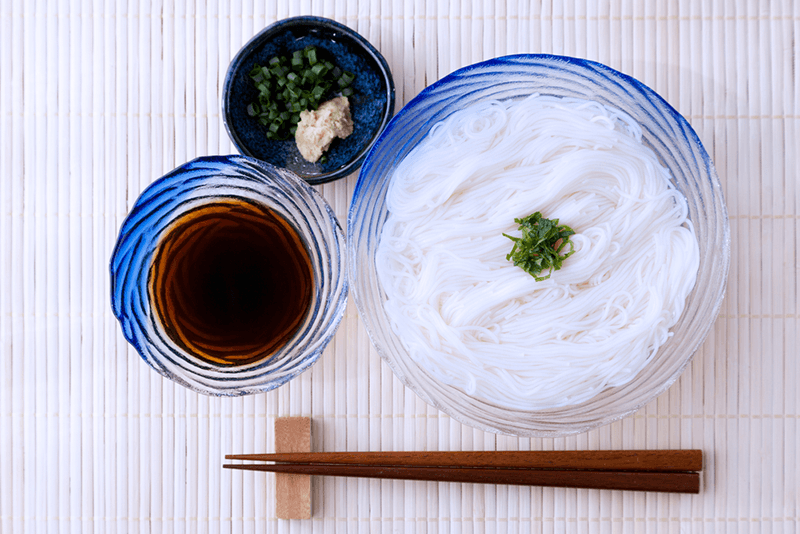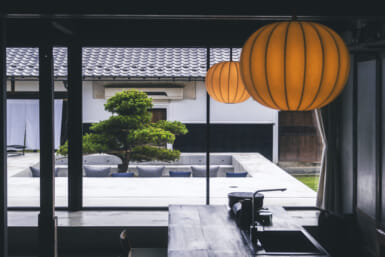Suki Yacking with Elizabeth Andoh (Tokyo Weekender, July 1975)
The hot and humid weather is upon us – it’s another Tokyo summer!
Today’s column gives two great culinary ways to cope with it all: somen (cold noodles) and kanten (a gelatine-like preparation).
Somen
ingredients:
1 bunch somen per serving
condiments:
grated fresh ginger-root (shoga); finely chopped scallions (negi); finely shredded shiso leaf
garnish:
lemon slices, cut very thinly
soba-jiru (dipping sauce):
2 cups dashi; 5 table-spoons usuguchi shoyu; 1 1/2 tablespoons regular shoyu; 3 tablespoons sugar; 2 tablespoons mirin
instructions:
1. Bring a large quantity of water (2-3 cups minimum for single serving; 7-8 cups for 4 servings) to a rapid boil in a large pot.
2. Add the somen (after untying each bunch; lay over boiling water like “pick-up-sticks”) and cup cold water. Wait until the water returns to a boil.
3. Add another 1/2 – 3/4 cup cold water and wait until the water returns to a boil again. Test a few strands of somen in a cup of cold water. If they’re translucent, they’re done; if still opaque, add cold water to the pot and wait for the water to boil again. Usually 2-3 “boilings” will be sufficent.
4. Strain the cooked somen and refresh it in a bowl of ice water.
5. Prepare the condiments (shoga, negi, shiso) and arrange them on a small plate. Prepare garnish and set aside.
6. Prepare soba-jiru by combining all the ingredients in a saucepan and heating thru until the sugar has melted. Stir to make sure all the ingredients have been well blended. Chill the soba-jiru or let it cool to at least room temperature (left-overs will keep for a week-10 days if covered in the refrigerator).
7. Serve the somen in deep bowls of fresh ice water. Garnish each bowl with a lemon slice. Each person should have a small, deep bowl for soba-jiru. Each person adds whatever condiments desired to his or her soba-jiru.
To eat: Lift out a mouthful of noodles from the ice water and dip them in the seasoned soba-jiru. Slurp and cat from there. Should the dipping sauce become too diluted (with the ice water that inevitably clings to the noodles), discard and replenish with fresh soba-jiru. Replenish condiments as necessary.
notes:
1. Somen are thin white noodles (dried) about 7-8 inches long. They usually come bound in bundles (about 1-inch in diameter) – one package may contain 5-10 bundles. Prices vary a great deal, but figure about ¥100-150 yen for one package. Occasionally, a single noodle in each bundle will be colored (pink or green, usually). This is for extra visual pleasure—it doesn’t affect the taste at all. Somen is eaten as a light snack or as a summertime starch substitute for rice, bread or potatoes.
2. Shiso leaves are broad and bright green and have a marvelous fragrence. They are sold in piles (about 10-15 leaves piled one on top of the other with the short stems held together by a rubber band) and should be rinsed with cold water and patted dry just before using. Roll up the leaf and slice it thinly across the grain. Figure on 2 leaves for every 2-3 servings, for those that really like it. A pile of shiso leaves usually costs loss than ¥100 in the height of the summer season.
3. Special somen dish sets are sold in the housewares section of department stores during the summer months. A set consists of five large deep glass bowls and 5 small deep glass bowls (all “sets” in Japan are of five, not six). Sometimes the sets are as cheap as ¥1,500-1,800. though real crystal can be as costly as ¥6-7,000 for a set. The dishes look cool and the ice tinkles and makes you feel cool, too. In addition, these sets are great for large, individual chef salads (use the small bowls for a variety of dressings).
* * *
Kanten
ingredients:
- 1 stick dried kanten
- 1 1/2 cups flavored liquid (fruit juice)
- 1 tablespoon sugar (optional)
- 1/4 cup fresh fruit (optional)
instructions:
1. Soak the stick of kanten in 1-2 cups cold water, breaking it up as it softens. Allow the kaiiten to soak for at least 20-30 minutes.
2. Shred the kanten and squeeze out all excess liquid.
3. Transfer the shredded kanten to a small saucepan into which the measured, flavored liquid and sugar (optional) have been added.
4. Heat slowly, stirring, until the kanten shreds have completely dissolved. Pour the kanten liquid into a mold (add fresh or drained canned fruit to the kanten liquid, if desired) and allow it to set. KANTEN WILL GEL WITHOUT REFRIGERATION, though chilling quickens the process.
5. Unmold (takes about 40 minutes to 1 hour to gel firmly) and slice, if necessary, before serving.
notes:
1. Kanten is sold two sticks to a pack; cost is about ¥120 for the package. Kanten looks like pale, silvery cellulose. It is very light weight and brittle in its dried state. It is manufactured from a type of marine vegetation called tengusa. Kanten will gel fresh pineapple (unlike regular gelatine). Already prepared kanten should be refrigerated if you don’t intend to eat it the same day. It will keep, refrigerated for 3-5 days.
2. The simplest flavored liquids: canned fruit juices.









